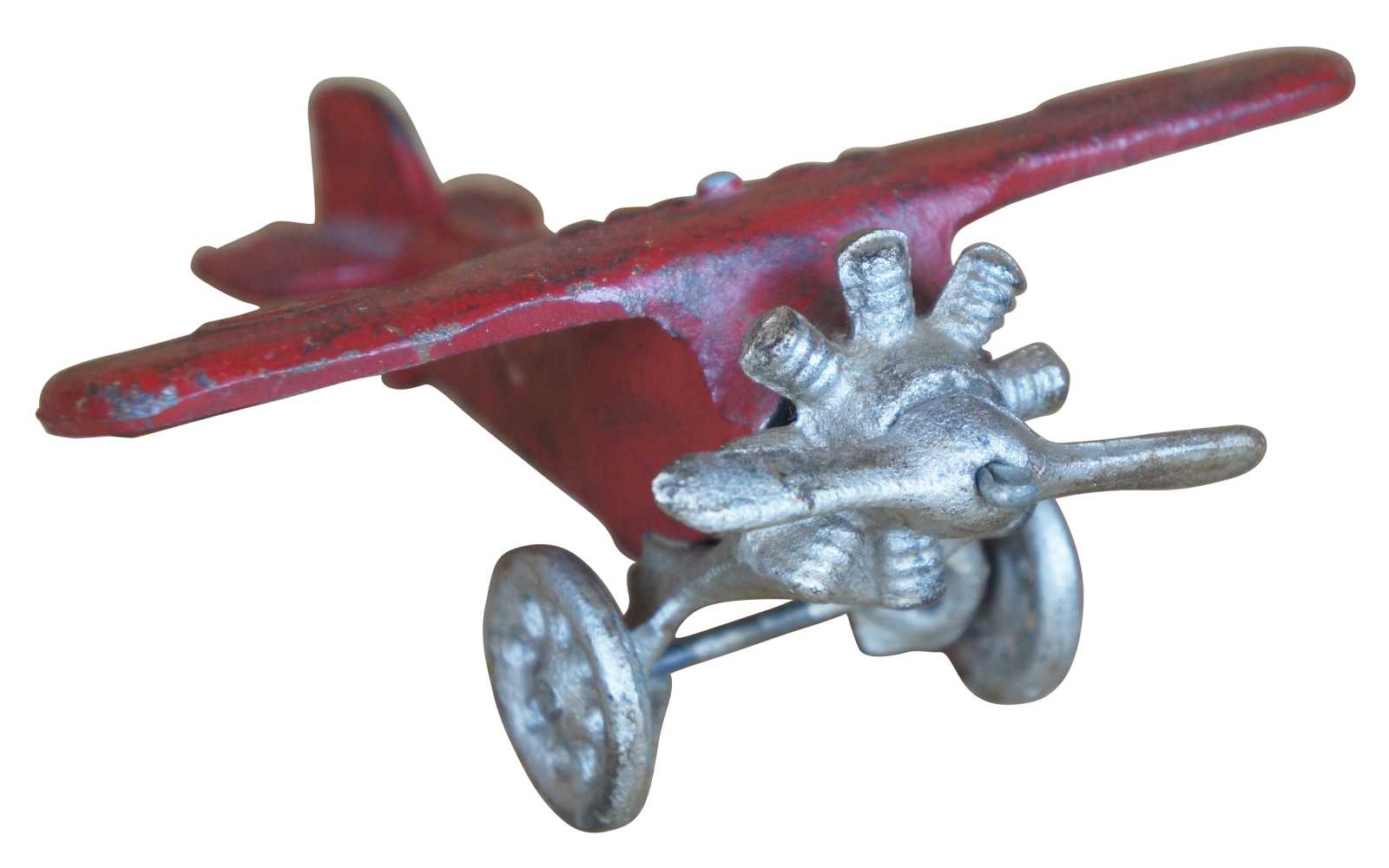
Shipping:
Free Shipping Included
Delivery:
Estimated 2-15 Business Days
Payments:
Credit Card, Check, Cash, PayPal, Apple Pay, Venmo
Returns:
30 Days 100% Money Back Guarantee, Buyer Pays Return Shipping
Description
Antique AC Williams UX 166 cast iron airplane toy.
A.C. Williams visited many towns and cities in northeastern Ohio and finally selected Ravenna. Until his death, he felt he had made no mistake as he was delighted with the town and its people. His business and the city of Ravenna grew and prospered. Erection of the plant was started in mid-winter, 1892-1893. The panic of September, 1893 struck the country and it was necessary to shut the plant down for several months. On resuming operation, Mr. Williams found the demand for sad irons diminishing and realized that a change of product was necessary. He finished up some sad irons by nickel plating and also produced some small models for his traveling salesmen. These small irons, a convenience for the salesmen, were the start of the toy business for The A.C. Williams Company.
There followed over the next thirty years, horse-drawn, then wheel toys, automobiles, tractors, and finally airplanes. At the same time and extending through this period were the various Cast Iron banks, including house banks, animal banks, several hundred different types and styles that have all become collectors items over the last twenty-five years. Through the 1920's, The A.C. Williams Company was recognized as the largest Cast Iron toy manufacturer in the world. In 1905, the business was incorporated as The A.C. Williams Company and Mr. Williams' son-in-law, J.H. Bigalow, moved to Ravenna from Cleveland, Ohio and became active in the business. The first Officers of the incorporated A.C. Williams Company were: A.C. Williams, President; his son, John W. Williams, Vice President; and his son-in-law, J.H. Bigalow, Secretary and Treasurer.
During the first World War, production of toys and banks decreased and the hardware line was expanded. At this time, the Company produced first castings for other companies to use in their product and most of these were related to war production items through 1916, 1917, and 1918. Immediately after the first World War, A.C. Williams, prompted by the illness of his wife and the decision of his son, John, and family to move to California, sold his interest in the business and moved to California. His son-in-law, J.H. Bigalow, became President of the Company and Clyde A. Heisler, son-in-law of Bigalow, became an Officer of the Company.
Gradual change was taking place in the toy and hardware business over the next few years. Stampings, plastics, and rubber toys were making inroads into the Iron toy line, which was sold principally through outlets like S.S. Kresge, F.W. Woolworth, and others. Stamped, and particularly, able foundry capacity unused, and with an excellent work force trained in small, thin-section castings with fine finish and a machineable Iron, C.A. Heisler, now Vice President, pushed the jobbing foundry business--the production of castings for other manufacturers. These requirements gradually utilized the entire foundry capacity and the last toys and hardware items were produced in 1937-1938.
By the late 1930's, White Sewing Machine Corporation had emerged as the largest customer of The A.C. Williams Company and more than one-half of the foundry's capacity was devoted to this one customer who required free machining, smooth surfaced, and very uniform castings. In 1940, with a definite trend toward light-weight castings and because the portable sewing machine was an excellent application for castings lighter than Iron, a pilot, or experimental plant was started in Magnesium by J.B. Heisler, who joined the Company in mid-1936 and was in charge of production. This occupied one small corner of what was known as Plant II on North Walnut Street, which served as additional foundry capacity primarily for uncored or plain work like sewing machine beds and motor ends. At about this time, a fine relationship started with Warner & Swasey Company on machine tool castings, first with the very smallest parts used on their various turret lathes and other machine tools, finally developing into the largest customer through World War II. To produce these castings and many others of heavier sections, it was necessary to make radical changes in the type of metal poured, and a laboratory was added to help control the metallurgy. It was not unusual to run two and even three types of Iron in one day to produce the wide range of castings now a part of The A.C. Williams Company.
Pearl Harbor and World War II changed the foundry operation from sewing machines, stoves, and other appliance parts, and lighting fixtures to machine tool castings, bomb plugs, grenades, half-trac castings and in the newly developed Magnesium Division, a variety of aircraft castings, including many kinds of wheels, structural castings and many radar parts. Manpower for all industries was under very rigid control. Women took over more of the production at A.C. Williams. More than half of the employees in the Core Departments were women and they replaced many men in Cleaning, Inspection, Painting and Finishing.
Victory in Europe and then V-J Day, brought about a rapid conversion to civilian production and the pent-up demand for sewing machines meant full employment and full production for A.C. Williams Company for the next five-year period. The Magnesium Division expanded into Aluminum and for a period of several years, additional Aluminum molding capacity was provided by a plant at Jones Brothers Structural Steel Company.
The Korean War again changed business conditions and while civilian items were not stopped, war-related casting requirements received preference and the production facilities at the Aluminum and magnesium Division were expanded to meet the increased aircraft casting requirements and to provide space for the Aluminum foundry that was brought back from the Jones building.
Condition
Good antique condition, wear, rust, finish loss.
Dimensions
6.25" x 5.75" x 2.75"h